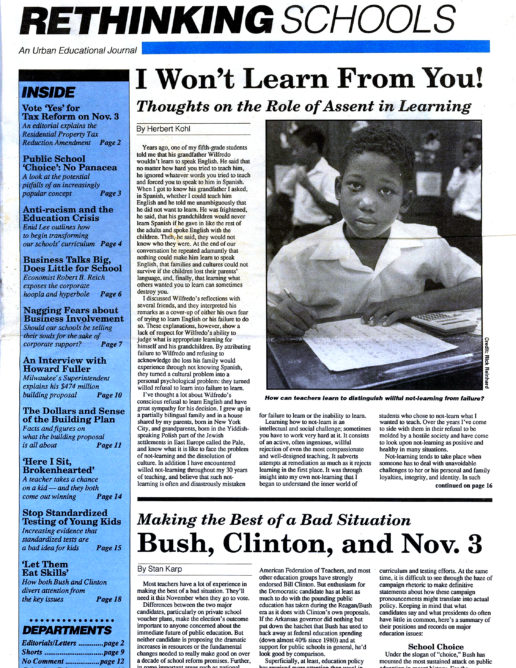The Dollars and Sense of the Building Plan
Will the Milwaukee Public Schools continue to educate children in coat rooms and corridors due to lack of space?
Will children in Milwaukee have access to the music, art, library and computer facilities commonly found in suburban schools?
Will the bulging class sizes in MPS early grades be reduced?
Will MPS provide enough classrooms so all eligible 4-and 5-year-olds can attend kindergarten?
Will schools be built in the neighborhoods where children live, rather than in outlying areas?
Should MPS build a new technical education high school?
Will Milwaukee taxpayers approve higher property taxes in order to improve educational quality in MPS?
Those are the key questions surrounding a proposed $474 million construction plan for MPS. Few have seriously questioned the educational rationale behind the plan’s fundamentals. Politically, the key debate surrounds the fact that MPS must ask voter approval for a bond that will finance $366 million of the plan.
In an interview on the preceding page, MPS Superintendent Howard Fuller addresses key criticisms that have erupted over the proposed building plan. An explanation of key components of the plan follows:
The plan is based on the recommendations of a task force of teachers, administrators, and parents. The recommendations were reduced by Fuller and presented to the school board last February. A series of public hearings was held in the spring, and another public hearing is set for October 19. The board, which has not yet approved the plan, is set to make a final decision on November 4. If approved, the referendum will most likely be set for next February.
The plan outlines a 10-year construction schedule, from 1992 to 2001. It calls for building 12 new elementary and two new middle schools in neighborhoods where there are not enough schools for area children, building a new technical high school to replace Milwaukee Trade and Technical High School, and expanding 14 existing elementary schools. One of the as-yet-unresolved controversies surrounding the building plan is a proposal to contract with private, community-based organizations to teach some of the new MPS students in the early grades.
On one level, the plan is designed to ensure that there are enough schools for the projected number of children who will attend MPS in future decades (Enrollment is projected to increase from approximately 93,500 students in 1992-92 to 108,831 in 2001-2002.) On another level, the plan is based on standards that will allow MPS to provide teaching conditions and facilities that are commonly found in suburban schools. These standards are:
- Implementing universal kindergarten for 4-year-olds for a half-day, and all-day kindergarten for 5-year-olds.
- Lowering class size to 19 students in kindergarten through second grade. Class sizes in these grades currently range from 25 to 27 students per class.
- Expanding libraries, providing adequate lunchrooms, and providing space for computer, art, and music classrooms
If the plan goes to a referendum, it will be the first time since 1970 that voters have been asked to approve a comprehensive construction plan. Several facilities plans were developed within MPS in the last decade, but were ultimately shelved because of fears the voters would not approve the money necessary.
Unlike the city and county, MPS must ask voters before it can spend money on what are called capital improvements— buildings and expanded facilities. As a result, both the city and county have spent considerably more than MPS in the last 10 years on capital spending. The city has spent $589.3 million more than MPS, while the county has spent $506.1 million more. In addition, the Milwaukee Metropolitan Sewerage District has spent $2.3 billion on the deep-tunnel and sewer expansion program.
The plan has come under sharp political attack by the administration of Milwaukee Mayor John Norquist and some people within the business community. The attacks have focused on the cost, not on the value of standards such as lower class sizes.
Fuller has stated clearly that while the costs seem high, the costs of doing nothing are even higher. Nor can the issue be simplistically reduced to one of higher property taxes, because those same taxes were used to fund other projects such as the $118 million new county jail and the multil-million dollar O’Donnell Park fiasco at the Milwaukee lakefront. The issue, fundamentally, is whether education reform and equity will move forward in this city, or be sacrificed under a politically hypocritical rationale of fiscal conservatism.

